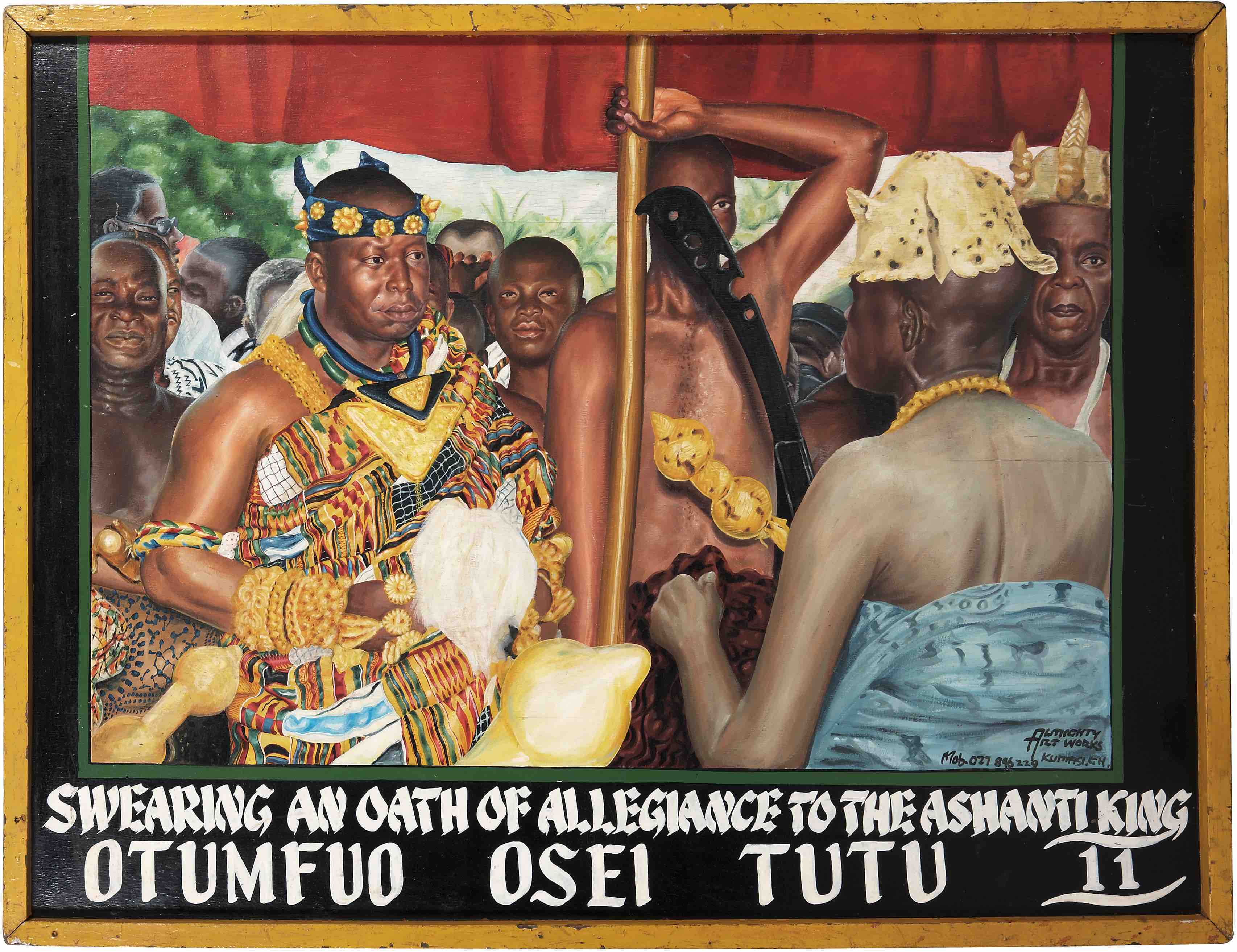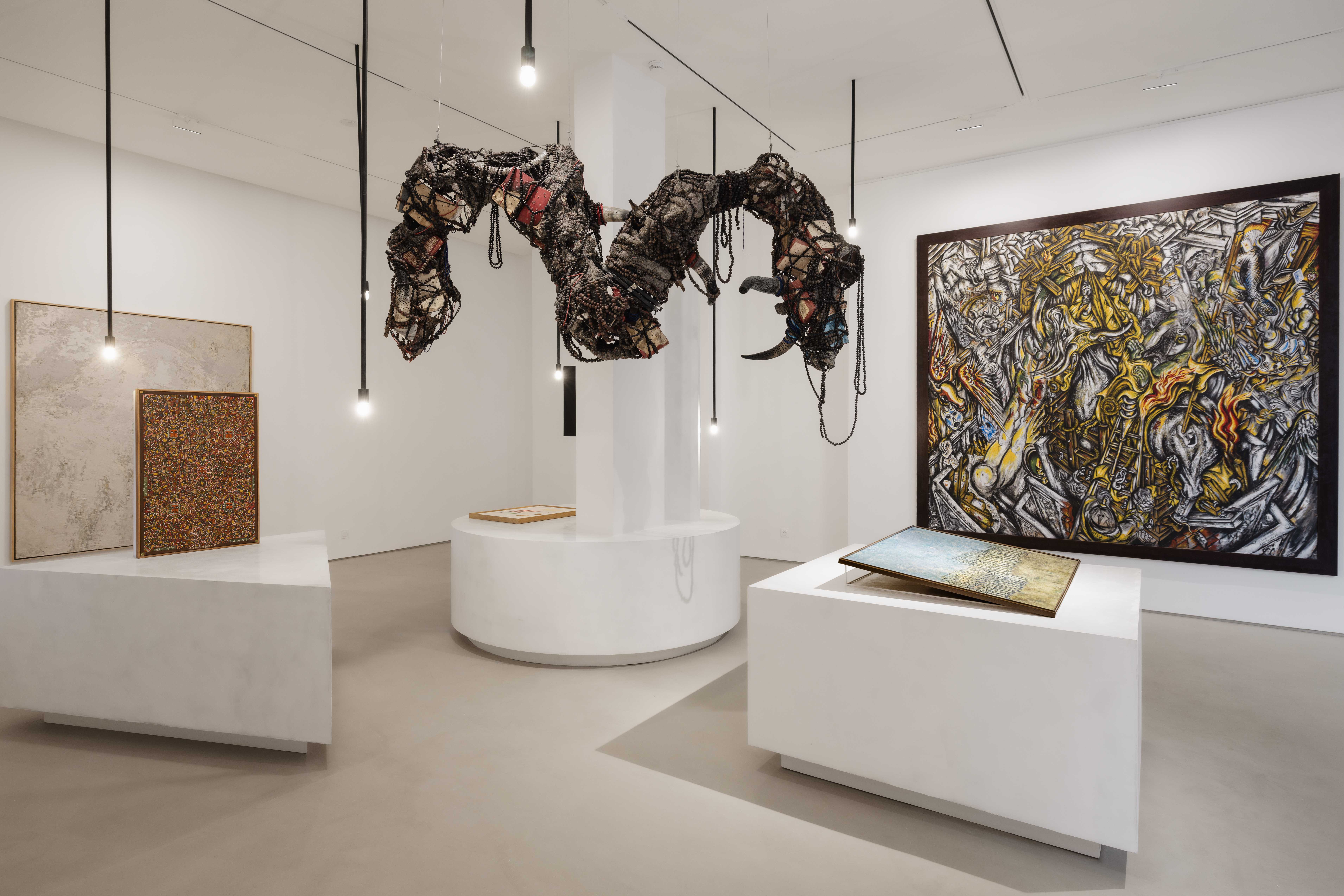تشهد المدن الكبرى والمراكز الحضرية في القارة الإفريقية تحولات جذرية، بسبب حركات الهجرة داخل القارة والأزمة البيئية. إن العلاقة بين العالم الريفي والحضري آخذة في التغير، من خلال أزمة المواد الخام وإزالة الغابات. تفتح هذه الأزمات والتحولات إمكانيات التعايش والتفكير في السكن بشكل مختلف. تشير الأعمال في هذه الغرفة إلى ظهور الفنان البيئي السياسي الذي يشارك في مالجة هشاشة أو هشاشة النظم البيئية الغير المستقرة والمناطق الزلزالية الأخرى.
Magi, healers, and herbalists possess rituals and expertise that are rarely revealed, yet they transport us into alternative realities, even inducing trance-like states. The artist-initiator explores the blurred boundary between the worlds of the occult and earthly forces at their own peril. They teach us forbidden gestures and knowledge to better resist commodification and the loss of identity.
مقابلة مع الفيلسوف وعالم الأنثروبولوجيا دينتيم توام بونا
Interview with the philosopher and anthropologist Dénètem Touam Bona
الفيلسوف والأنثروبولوجي والفنان والمنسق، دينتم توام بونا، هو أحد هؤلاء المؤلفين الأفرو-أوروبيين، الذين يتمتعون بهوية حدودية، ويعيدون تقييم المعارف المقدسة أو الطقوسية في ضوء شروطنا المعاصرة. في كتابه "حكمة الداليات" (2021)، يقدم لنا "شعرية كونية للملجإ" التي تتحدى المعايير الاجتماعية السائدة؛ لصالح الكيانات الطبيعية وأشكال الحياة البسيطة، مثل بعض النباتات، التي تحتوي على موارد جديدة للتحرر أو الترفّع.
Philosopher, anthropologist, artist, and curator Dénètem Touam Bona is an Afro-European author with a border identity, who re-examines sacred and ritual knowledge in light of our contemporary condition. In La sagesse des lianes (2021), he presents a "cosmo-poetic refuge" that challenges dominant social norms in favour of natural entities and minor forms of life, such as certain plants, that offer new possibilities for liberation and transcendence.

كوامي أكوتو (غانا، مواليد 1950) المعروف باسم "الله القدير"
Kwame Akoto (Ghana, born in 1950) known as Almighty God
كوامي أكوتو، الذي بدأ كرسام لوحات إعلانية منذ شبابه، بدأ نجاحه يتبلور منذ عام 1972. في ذلك الوقت، افتتح ورشته الخاصة باسم "ورشة الله القدير" في حي الميكانيكيين في كوماسي بغانا. يعكس هذا الاسم، الذي أصبح لاحقًا اسمه الفني، تجربته في الكشف الإلهي واستجابته لدعوة الله. يجمع أكوتو بين عمله كرسام لوحات إعلانية، حيث يزين المحلات التجارية في جميع أنحاء المدينة بصوره ورموزه، وبين مسيرته كفنان تُعرض أعماله في المتاحف حول العالم. في غانا، تظهر لوحاته على لوحات تحذيرات المرور، وكذلك على لوحات صالونات الحلاقة. تتميز أعماله بدمج الصورة والنص وفق رموز هجينة تجمع بين الطابع الإعلاني والبعد الروحي، حيث ترتبط بقوة بالطقوس المقدسة أو الشعبية. منذ عام 1990، انضم كوامي أكوتو إلى طائفة "بيت خدمات الإيمان" "House of Faith Ministries"، حيث يعمل حتى اليوم كقسٍ ومعالج مشهور. ومنذ ذلك الحين، اكتسبت شعارات أو مدائح لوحاته طابع عبارات الكتاب المقدس. يعتمد أكوتو غالبًا في لوحاته على صور مأخوذة من الصحف، مستكشفًا مواضيع متنوعة مثل المسيحية، الرؤى الشيطانية، مشاهد الاحتفال، أو حتى الحداد. كما يظهر في هذا الطقس الخاص بقسم الولاء لملك الأشانتي أوسي توتو الثاني، لا يتردد أكوتو في الغوص في التاريخ القديم لغانا وإمبراطورية الأشانتي التي وُجدت بين منتصف القرن السابع عشر وبداية القرن العشرين؛ وكأنها استدعاء لأرواح تنبعث من ماضي ما قبل الاستعمار.
Kwame Akoto, who became a professional sign painter as a youth, found his path to success in 1972. It was then that he opened his own studio under the name of “Almighty God Workshop” in the Kumasi mechanics’ district in Ghana. This title, which he would later adopt as his artist’s name, actually bears witness to his personal revelation and the call of God. His practice easily incorporates the dual role of sign painter by day—applying his images and symbols to shopfronts across the city—and artist whose work is shown in international museums. In Ghana, his images can be seen everywhere, from road safety signs to beauty salons. His paintings combine image and text, using hybrid codes that are both advertising and mystical, in the sense that they cultivate a strong link with sacred or popular rituals. From 1990 onwards, Kwame Akoto joined the Pentecostal sect of House of Faith Ministries, where he continues to practice today as a renowned pastor and healer; the slogans and praises in his paintings thus take on a biblical connotation. Kwame Akoto often paints from photographs gleaned from newspapers, exploring Christian themes, demonic visions, scenes of celebration and mourning. As we see with this ritual of allegiance to the Ashanti king Osei TuTu II, he does not hesitate to delve into the ancestral history of Ghana and the Ashanti Empire, which existed between the mid-17th and early 20th centuries, like an invocation of spirits resurfacing from a distant pre-colonial past.
الفنانون المعروضون
Exhibited Artists
محمد أبو الوقار، كوامي أكوتو، فؤاد بلامين، تاكوندا ريجيس بيليات، مالك الكناوي، سعد حساني، جورج ليلانغا، ماوي مازكابو جيرا، ابتهال الرملي، مايا إيناس توام، دومينيك زينكبي
Mohamed Abouelouakar, Kwame Akoto, Fouad Bellamine, Takunda Regis Billiat, Malek Gnaoui, Saad Hassani, Georges Lilanga, Mawi Mazgabu Gera, Josèfa Ntjam, Btihal Remli, Maya-Inès Touam, Dominique Zinkpè


